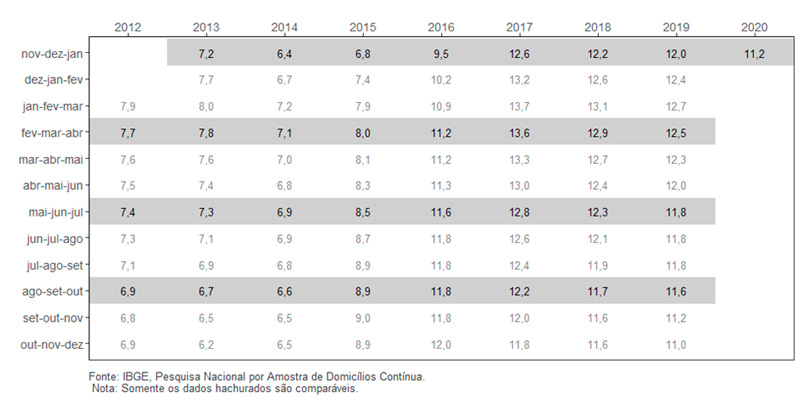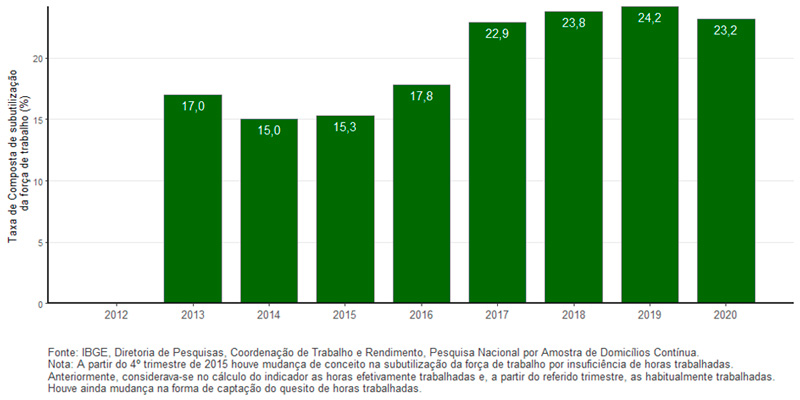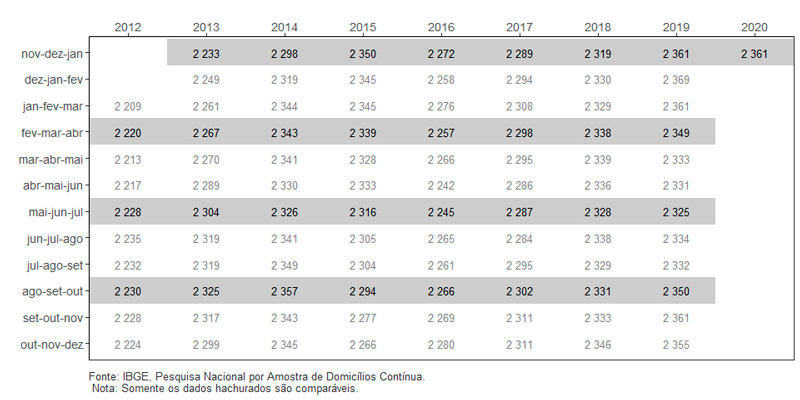Unemployment rate is 11.2%, underutilization rate is 23.2% in quarter ended in January 2020
February 28, 2020 09h00 AM | Last Updated: March 02, 2020 11h27 AM
The unemployment rate (11.2%) in the moving quarter ended in January 2020 fell in both comparisons: -0.4 percentage points (p.p.) in relation to the August-October 2019 quarter (11.6%) and -0.8 p.p. in relation to the same quarter last year (12.0%).
| Indicator / Period | Nov-Dec-Jan 2020 | Aug-Sep-Oct 2019 | Nov-Dec-Jan 2019 |
|
|---|---|---|---|---|
| Unemployment rate | 11.2 | 11.6 | 12.0 |
|
| Underutilization rate | 23.2 | 23.8 | 24.2 |
|
| Usual real earnings | R$2,361 | R$2,350 | R$2,361 |
|
| Change of the usual real earnings in relation to: | 0.5% (stable) | 0.0% (stable) |
||
The unemployed population (11.9 million persons) reduced in both comparisons: -3.7% (or less 453 thousand persons) compared with the previous moving quarter and -5.6% (less 712 thousand persons) in relation to the same quarter last year.
The employed population (94.2 million) remained stable in relation to the previous quarter. It rose 2.0%
(more 1.9 million persons) in relation to the same quarter a year ago.
The informality rate hit 40.7% of the employed population, representing a contingent of 38.3 million informal workers. This rate had been 41.2% in the previous moving quarter and 40.6% in the same quarter last year.
The population out of the workforce (65.7 million persons) increased 1.3% in relation to the previous moving quarter (more 873 thousand persons), whereas it remained stable in relation to the same quarter a year ago.
The compound underutilization rate of the workforce (23.2%) changed -0.6 p.p. in relation to the previous moving quarter (23.8%) and -1.0 p.p. in relation to the same moving quarter last year (24.2%).
The underutilized population (26.4 million persons) dropped -2.7% (less 744 thousand persons) against the previous moving quarter (27.1 million) and -3.4% (less 919 thousand persons) against the same quarter a year ago.
The discouraged population (4.7 million) remained statistically stable in both comparisons, as well as the percentage of discouraged in relation to the population in the workforce or discouraged (4.2%).
The number of employed persons with a formal contract in the private sector – excluding domestic workers – reached 33.7 million and increased in both comparisons: 1.5% (more 504 thousand persons) compared with the previous moving quarter and 2.6% (more 845 thousand persons) in relation to the same quarter last year.
The category of those employed without a formal contract in the private sector (11.7 million persons) remained stable in relation to the previous moving quarter and increased 3.7% (more 419 thousand persons) compared with the same quarter of 2019.
The number of self-employed workers hit 24.6 million persons and remained stable in relation to the previous moving quarter. It rose 3.1% (more 745 thousand persons) in relation to the same period a year ago.
The average usual real earnings (R$2,361) in the moving quarter ended in January 2020 remained stable in both comparisons.
The average usual real wage bill (R$217.4 billion) held steady against the previous quarter and grew 2.2% over the same quarter last year.
Unemployment Rate - Brazil - 2012/2020

The employment-population ratio – percentage of employed persons at working age – was estimated at 54.8%, remaining stable in relation to the previous moving quarter (54.9%) and increasing 0.6 p.p. in relation to the same quarter of 2019 (54.2%).
Estimated at 106.1 million persons, the workforce – employed and unemployed persons – remained stable in relation to the previous moving quarter and grew 1.1% (more 1.1 million persons) against the same quarter of 2019.
The potential workforce (7.9 million persons) remained stable in both comparisons.
The contingent out of the workforce was estimated at 65.7 million persons in the quarter from November 2019 to January 2020 and changed 1.3% in relation to the previous moving quarter, remaining stable over the same moving quarter a year ago.
Compound underutilization rate – quarters from November to January – 2012/2020 Brazil (%)

The number of time-related underemployed persons (6.6 million) retreated (-5.7% or less 403 thousand persons) against the previous moving quarter and remained stable against the same quarter of 2019.
The category of the employers (4.4 million persons) remained stable in relation to the previous moving quarter and also to the same quarter of 2019.
The categories of domestic workers (6.3 million persons) and of those employed in the public sector (11.5 million persons), which includes statutory servants and military, did not register any statistically-significant change.
Employment held steady in all the activity groups in relation to the previous moving quarter.
In relation to the same moving quarter of 2019, employment increased in three activity groups: General industry (4.4% or more 512 thousand persons), Transportation, storage and mailing (4.5% or more 213 thousand persons) and Other services (5.7% or more 276 thousand persons). The other groups did not show any significant change in this comparison.
The average usual real earnings received in the main job remained stable in all the activity groups in both comparisons.
Average monthly real earnings, usually earned in the reference month,
from all jobs of employed persons - Brazil - 2012/2019 - (R$)


